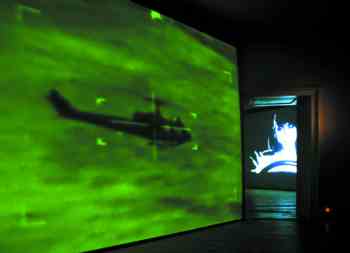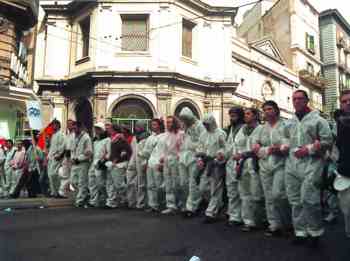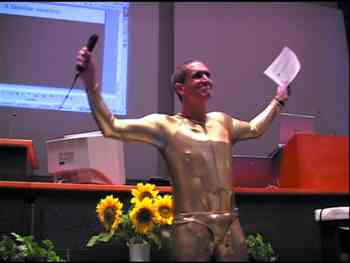Unleashing the Collective Phantom (Resistance to Networked Individualism)
Today’s ‘self-managed’ or sociological type has been shaped overwhelmingly by the impact of ‘60s counter-culture. Jettisoning the disciplinary schemas of modernity, capitalist production models – of goods and subjects – have taken on board the anti-authoritarian demands of the flower power generation. But, argues Brian Holmes, our newfound flexibility, mobility and interactivity is both repressive and liberatory by turns. It is able to create both the extreme individualisation of cybernetic market research and the anti-individualism of the multiple name – two polarities which define and open a new space of struggle.
The classical function of the stock market is to provide resources for industrial development, through a speculative game that pays off later in the ‘real economy’. But history is cunning, and the result of the dotcom boom may have been to free up vast amounts of private money for the development of a virtual public realm, where people can confront the major corporations on their home turf – that is to say, in transnational space. Huge amounts of infrastructure were installed throughout the world in the period from 1995 to 2000; now the oversupply crisis is accounted a disaster. An alternative history turns that equation upside-down. The speculators of the late 20th century asked: ‘Is there any limit to the profit we can make off the internet?’ Today a wilder speculation has arisen: ‘Can we really make the networks useless for corporate capitalism?’
Unlike most people, I don’t think the answer is primarily legal, or even technological. Instead it is cultural and artistic. It has everything to do with subjective capacities for resistance, and a history of resistance might suggest a different question: ‘Can the expanding virtual class finally escape the domination of the flexible personality?’
PARADIGM SHIFTFrom Taylor and Ford to Stalin and De Gaulle, the adversary of the radical Left in the 20th century was rationalising authority. Whether on the factory floor or in the military ranks that gave the orders, regimentation and the hierarchical pyramid supplied the images of authoritarian oppression. The difference between East and West was slim in that respect. The army muster and the assembly line set the pace of life on both sides of the Iron Curtain. The first to analyse this situation was the Frankfurt School.
The originality of the Frankfurt School was to combine Marx and Freud, to explore the industrial economy’s masochistic libido. But to do so was not just to go beyond the pleasure principle. What the Frankfurt School studied from the 1930s onward was a new form of political-economic command that stretched its social fingers deeply into the psyche. The liquidation of nineteenth century bourgeois individualism and the emergence of a central-planning state, along with a totally mobilised factory society, were pursued on the subjective level by what they called the authoritarian personality. They understood this fascistic character structure as a ‘new anthropological type.’ Its traits were rigid conventionalism, submission, opposition to everything subjective, stereotypy, an exaggerated concern with sexual scandal, emphasis on power, and the projection of unconscious impulses.
The Frankfurt School writers perfected their analysis of the authoritarian regimes in the 1940s and ‘50s, while living in exile in the USA. There they saw Prussian parade ground discipline transforming into the softer coercions of behaviourist psychology and the culture industry. We know the new forms of revolt that arose in the 1960s against those standardising forces: everything from Reichean group sex, burning draft cards and dollar bills, to Provo events, situationist drifting and LSD. What Marcuse called ‘outbreaks of mass surrealism’. On a deeper level there was an assertion of subjectivity, of identity, of sexuality, the personal as the political. A poetics of resistance helped bring the decline of regimentation, welfare state bureaucracies, mass-consumption models and factory discipline. But are we even aware how that decline helped shape today’s political-economic system?
In response to the troubles of the 1960s and ‘70s, a new paradigm has arisen in the developed countries in the past twenty years, with a specific production regime, consumer ideology and social control mechanism, all integrated into a geopolitical order. For almost twenty years this development remained largely unconscious, unnameable. During that time, vanguard movements were obsolete, intellectuals were useless, artists were clowns, there was no alternative. Now the cracks are opening up everywhere. People are realising that the New World Order is not just oppressive at its edges, in the so-called developing countries. At the very heart of casual freelance culture, replete with PCs, mobile phones and general nomadism, the technology of control is continuously recreated. Winning the economic game today brings a high reward. You get to be the inventor of the flexible personality.
CULTURE/IDEOLOGYNew paradigms are adopted because they work. Only in retrospect can we see them becoming modes of control. Flexibility was an extremely positive idea in California in the 1970s when the culture of microelectronics was invented. It was the polar opposite of the rigid 1950s: openness to others, embodied experience, self-expression, improvisation, refusal of hierarchies and discipline. These were the utopian days of Bucky Fuller, Gregory Bateson and the Whole Earth Catalog: no-one would have dreamt that An Ecology of Mind could become a management tool. But the looser, more creative lifestyle did not just mean the emergence of a whole new range of products, useful for stimulating consumption. In California, and ultimately in much of the developed world, the new culture seemed to promise a way out of the social conflicts that had stalled the Fordist industrial regimes.
Consider the way things looked to the Trilateral Commission in their 1975 report on The Crisis of Democracy. Not only were Third World countries using the powers of national liberation to demand higher prices for their resources while the US lost its war in Indochina. Not only were the capital returns plunging while wildcat strikes multiplied and the big ecological standoffs began. But worst of all, the huge postwar investments into socialised education, conceived to meet the knowledge needs of the techno-economy, were backfiring and producing resistance to capitalism and bureaucracy, alternative values, demands for further benefits and socialisations. These new claims on the welfare state had to be added to the traditional demands of the working class; and then the crisis began. The Trilateral countries were becoming ‘ungovernable,’ there was an ‘excess of democracy’. The kind of systemic critique that the Frankfurt School had pioneered reached its height in the mid-1970s. From that point on, the authoritarian system had to start learning from the enemy within.
The transformation took a decade. The golden age of neo-management began in the mid-1980s, while unionised workers were replaced with robots and unskilled labour was sought overseas. Corporate operations and financial flows expanded outside nations, where regulation and redistribution were deemed excessive. The triple challenge for the managers was to keep tabs on a distant work force, to open up global marketing and distribution, and above all, to create a culture – or an ideology – that would entice significant amounts of younger people to run this new machine. The key word was ‘flexibility’. The flexible system had to accept and divert the demands for autonomy, self-expression and meaning, it had to turn those very demands into a new mode of control. The magical answer turned out to be a communications device, a language-and-image transmitter: the networked personal computer. Now the computer was going to set you free.
Freedom has always been the great neoliberal watchword, from Hayek and the Chicago economists to the right-wing libertarians and the Cato Institute. Why not throw in the artists’ and the drop-outs’ dreams, roving desire, semiotic proliferation, Deleuzo-Guattarian schizophrenic visions, multi-culti creativity? After all, the innovations were coming from there. The networked computer promised to place a whole new alchemy of cooperative production in the same kinds of global channels that were already working for the finance economy. Research and invention could happen directly within the circuits of production and distribution.
The laptop computer freed up individuals for physical and psychic mobility, and it could also be used as an instrument of control over distant labour. It miniaturised access to the remaining bureaucracy, while opening private channels into entertainment, media and the realms of ‘fictitious’ capital – the speculative economy that feeds off the dismantling of the public sphere. Best of all, it recoded every kind of cultural production as commodities, multimedia. Here was a mode of development that might solve or at least gloss over the full set of problems inherited from the 1960s, particularly the struggles around the welfare state. Small wonder that the governments and the corporations started actively promoting a myth of flexibility. The emerging ‘virtual class’ – including cultural producers, digital artisans, prosumers, what are now called ‘immaterial labourers’ – stumbled more or less blindly into it.
GUIDANCE SYSTEMSHow does the culture/ideology work? War is popular these days, so let’s take the military point of view. The weapon of choice during the Cold War was the ICBM: a huge, never-used giant, endlessly deconstructed by the critiques of phallo-logo-centrism. The New World Order takes off with a smaller, more practical device: the cruise missile. This kind of weapon gets constantly used, not just on the battlefield. Since the heyday of Star Wars – both the Strategic Defence Initiative and the Lucas movie – the military-entertainment complex has become part of everyday experience.
‘It seems that retailers will go to any length to capture customers,’ reads a 1997 article called ‘Star Wars turns on to Shoppers’ (quoted by Sze Tsung Leong in The Harvard Guide to Shopping). ‘Witness Safeway, which has recently used an artificial intelligence system from IBM called AIDA (artificial intelligence data architecture) – which was initially developed to detect and identify Russian missiles in space, but is now used... to analyse information on buying patterns with details of purchase from loyalty cards.’ When consumer desire is ‘turned on’ and encouraged to proliferate, the ultimate control fantasy becomes that of tracking the flexible personality.
‘Mass marketing, for all intents and purposes, is dead,’ writes business guru Art Weinstein, in Market Segmentation. ‘Precision target marketing... has taken over. By focusing on ever smaller yet profitable market segments, stronger company-customer relationships transpire. With technological products, users can practically invent markets for companies – customers become customisers.’ When feedback devices are built directly into the distribution circuits, the sources of desire are directly available to corporate monitoring. So you can help perfect your own internal guidance system.
Until recently, such trends seemed comfortably ambiguous – just the irritating price for increased freedoms. But with security-fever rising after September 11, everything starts to look different. The incitement to perform, to find creative ways of deploying the new equipment, reveals its hidden face, the fear of the excluded other, the imperative to ruthlessly extend and perfect the system. And the system really is threatened, not only by suicidal terrorism, but by the collapse of the ‘new economy,’ the growing protests against neoliberal globalisation, the revolution against the IMF in Argentina... The perfect solution is total mobilisation, the shift to a wartime footing. September 11 was a chance just waiting to be taken – the chance to consolidate the new paradigm on every level.

>> Jordan Crandall, Drive, 2000. Installation view, Neue Gallerie am Landesmuseum Joanneum, Graz
The American artist Jordan Crandall has made the military compulsions of the networked system visible. His work began with the heritage of the 1970s: experimentation, cooperation, networked performance, adjustment to the presence of others in virtual space. But in 1998, he hired a freelance military contractor to help him develop movement-predicting software, whose algorithms show up as eerie green tracery around bodies in a video image. The following exhibitions, Drive and Heat-Seeking, were fully-fledged explorations of the psychosexual relations of seeing and being seen, through the new technologies in both their civilian and military uses.
Crandall recently published an article called ‘Fingering the Trigger’ on the Nettime mailing list, which recounts the CIA’s use of an unmanned, camera-and-missile-equipped Predator drone to fire upon a suspicious Afghani man who, it turns out, was probably just scavenging for metal. ‘We align eye, viewfinder, and target in an act of aiming,’ Crandall writes. ‘But we are aimed at, we are constituted in other acts of looking. These are analysis and control systems in which the body is situated... It sees us as a nexus of data, materiality, and behaviour, and uses a language of tracking, profiling, identifying, positioning and targeting... Within the circuitous visualisation networks that arise, one never knows which “side” one is truly on, as seer switches to that which is seen; as targeter switches to that which is targeted.’ Crandall thinks a new sexuality lodges in the body-machine-image complex – hence the image of the soldier-man ‘fingering the trigger.’
This work helps us see what the easy money and pluralism of the Clinton years kept hidden: the outlines of a social pathology. It has an authoritarian cast – like everything that involves the military – but it does not produce unthinking, stereotyped behaviour of the kind we associate with fascism. What Crandall describes is an extremely intelligent process that, precisely by individualising – tracking, identifying, eliciting desire, channelling vision and expression – succeeds in binding the mobilised individual to a social whole. The new fascism discovers a complex, dynamic order for subjective difference, perspectival analysis, jouissance, even schizophrenic ecstasy. It integrates networked individualism.
GHOST IN THE MACHINEArthur Kroker had an inkling of these things. Almost a decade ago he and Weinstein wrote about the ‘liberal fascism’ of the ‘virtual class’: a technological elite, driven by possessive individualism, whose interests lay with the financial establishment, the military state and the big corporations. But like all neo-situationists in Baudrillard’s wake, Kroker is obsessed by ‘the recline of the West’ and the hypnotic power of the digitised image: ‘The virtual class is populated by would-be astronauts who never made it to the moon,’ reads a passage from Data Trash. ‘They do not easily accept criticism of this new Apollo project for the body telematic.’
No doubt that was true in 1994, when the text was written. But the virtual realm has expanded vastly since then, and with it, the space for critique. One major effort has been to describe the new mode of domination. Another is to create a poetics of resistance: virtual class relations, alongside the embodied ones that never disappeared.

>> AAA For Sale
Consider the Association of Autonomous Astronauts (AAA), founded in 1995 with a five-year mission to establish a planetary network to end the monopoly of corporations, governments and the military over travel in space. The AAA is a kind of multiple name, a freely invented identity. Forget about the moon, ‘Reclaim the Stars’ they said on 18 June 1999, during the Carnival against Capital. The idea was not to create an art group, but a social movement – a collective phantom acting on a global scale. ‘Unlike a multiple name that is restricted to art practices, a collective phantom operates within the wider context of popular culture, and is used as a tool for class war,’ says an astronaut of the South London AAA, in a text called ‘Resisting Zombie Culture.’
One aspect of the project was infrastructural mapping, identifying the satellite hardware that links up the world communications network. But another was what Konrad Becker calls ‘e-scape’: ‘Cracking the doors of the future means mastering multidimensional maps to open new exits and ports in hyperspace; it requires passports allowing voyages beyond normative global reality toward parallel cultures and invisible nations; supply depots for nomads on the roads taken by the revolutionary practice of aimless flight.’ Ricardo Balli gives a further idea of what the galactic phantom might do: ‘We are not interested in going into space to be a vanguard of the coming revolution: the AAA means to institute a science fiction of the present that can above all be an instrument of conflictuality and radical antagonism.’ (Both quotes are from Quitter la gravité [http://www.lyber-eclat.net])
What does it all mean? The ideas sound fantastic, but the stakes are real: imagining a political subject within the virtual class, and therefore, within the economy of cultural production and intellectual property that had paralysed the poetics of resistance. Consider Luther Blissett, an obscure Jamaican football player traded from Britain to Italy, who fell short of stardom but became a proliferating signature, a multiple name, the ‘author’ of a book called Mind Invaders: How to Fuck the Media. Between tales of Ray Johnson and mail art, Blissett takes time out for some political-aesthetic theory: ‘I could just say the multiple name is a shield against the established power’s attempt to identify and individualise the enemy, a weapon in the hands of what Marx ironically called “the worst half” of society. In Spartacus by Stanley Kubrick, all the slaves defeated and captured by Crassus declare themselves to be Spartacus, like all the Zapatistas are Marcos and I am all we Luther Blissetts. But I won’t just say that, because the collective name has a fundamental valence too, insofar as it aims to construct an open myth, elastic and redefinable in a network....’

>> Ya Basta principles in practice
The ‘open myth’ of Luther Blissett is a game with personal identity, like the three-cornered football played by the AAA: a way to change the social rules so a group can start moving simultaneously in several directions. This ‘fundamental valence’ lies at the prehistory of the counter-globalisation movement. Just think of the way names like Ya Basta, Reclaim the Streets, or Kein Mensch ist Illegal have spread across the world’s social networks. One can see these names, not as categories or identifiers, but as catalysts, departure points, like the white overalls (tute bianche) worn initially in north-eastern Italy: ‘The Tute Bianche are not a movement, they are an instrument conceived within a larger movement (the Social Centres) and placed at the disposal of a still larger movement (the global movement),’ writes Wu Ming, in the French journal Multitudes. This ‘instrument’ was invented in 1994, when the Northern League mayor of Milan, Formentini, ordered the eviction of a squatted centre and declared, ‘From now on, squatters will be nothing more than ghosts wandering about in the city!’ But then the white ghosts showed up in droves at the next demonstration, and a new possibility for collective action emerged: ‘Everyone is free to wear a tuta biacha, as long as they respect the “style”, even if they transform its modes of expression: pragmatic refusal of the violence/non-violence dichotomy; reference to zapatismo; break with the 20th-century experience; embrace of the symbolic terrain of confrontation.’
Yet a strange thing happened, explains Wu Ming in another text: ‘Some rhetorically opposed the white overall and the blue overall, and the former was used as a metaphor for post-Fordist labour – flexible, “precarious”, temporary workers whom the bosses prevent from enjoying their rights and being represented by the unions.’ [www.wumingfoundation.com]. Between politics, class uncertainty and sheer word play, the Tute Bianche got into full swing. The technique of ‘protected direct action’ – allowing ludicrously padded protesters to face blows from the police – was a way to invade, not just the media screens, but above all the minds of hundreds of thousands of other people. They converged in Genoa in July 2001, to open a real political debate in a country stifled by a neofascist consensus.
Another example of the effects created by a confusion of identities is the Yes Men, in their cameo or ‘chameleo’ appearances as representatives of the World Trade Organisation. Here we’re talking about two artists, whose names aren’t hard to discover, but which makes the uncertainty over language no less interesting. To say ‘yes’ to neoliberal ideology can be devastatingly satirical, as when the self-elected WTO representative ‘Hank Hardy Unruh’ displayed the logical fiction of the Employee Visualisation Appendage, a telematic worker-surveillance device in the shape of a yard-long golden phallus. But what kind of satire is at work when Kein Mensch ist Illegal takes the neoliberal ideology seriously, and declares all the world’s borders open, for everybody? (See Florian Schneider in this issue.) Like the fire-coloured masks worn by thousands in Quebec City, today’s networked protests have two faces: the laughter of open communication, or the violence of a gagged mouth behind a chain-link fence. Both faces are the truth of the contemporary political confrontation.
VOICE AND EXITNo doubt millions of the world’s ‘flexible’ workers remain largely gagged – mute – with no voice and no hope of escaping. But as use of the internet has increased, and as people have seized its communicational power for both organisation and subversion, a metamorphosis has invaded the ‘transnational public sphere,’ which formerly was only open to the corporations. The global e-scape remains virtual, but in the sense of Deleuze: virtuality as latency, as unmanifest reality, potential flight-lines waiting to be taken.
The virtual class in this sense, or the immaterial labourers – I’ve always preferred to say networkers – cannot stand in for the rest of the world’s population. There is no universal subject, not even ‘the individual.’ But an active indistinction of identity has begun to spread, like a new departure point. In a recent text, Paolo Virno locates the universal in pre-individual aesthetic and linguistic experience, in the impersonality of perception and circulating language. The chaotic dissension of public space then becomes the landscape, not of defensive individualism, but of evolving paths to individuation: ‘Far from regressing,’ writes Virno, ‘singularity is refined and reaches its peak in acting together, in the plurality of voices, in short, in the public sphere’ (Multitudes #7).
The kinds of conflict that began in the universities in the 1960s have crossed over into the global knowledge-space, whose nature as a public domain in now intensely at issue. If the new voices and political confrontations should ultimately point to an exit from the flexible personality, and from liberal fascism, then there will have been no waste in the speculations of the late 1990s – whatever the multiple names of the investors.

>> RTmark: Andy is proud as a dictator CEO on cocaine.
Brian Holmes is an art critic, activist and cultural theorist, author of the forthcoming book of essays, Hieroglyphs of the Future: Art and Politics in a Networked Era
Association of Autonomous Astronauts [http://www.uncarved.demon.co.uk/aaa.html][http://aaa.t0.or.at/][http://www.geocities.com/ResearchTriangle/7535/AAA1.htm][http://www.deepdisc.com/aaa/]The Yes Men[http://www.theyesmen.org/]Kein Mensch ist Illegal[http://www.contrast.org/borders/kein/]Ya Basta[http://www.yabasta.it/]Luther Blissett [http://www.lutherblissett.net/]
